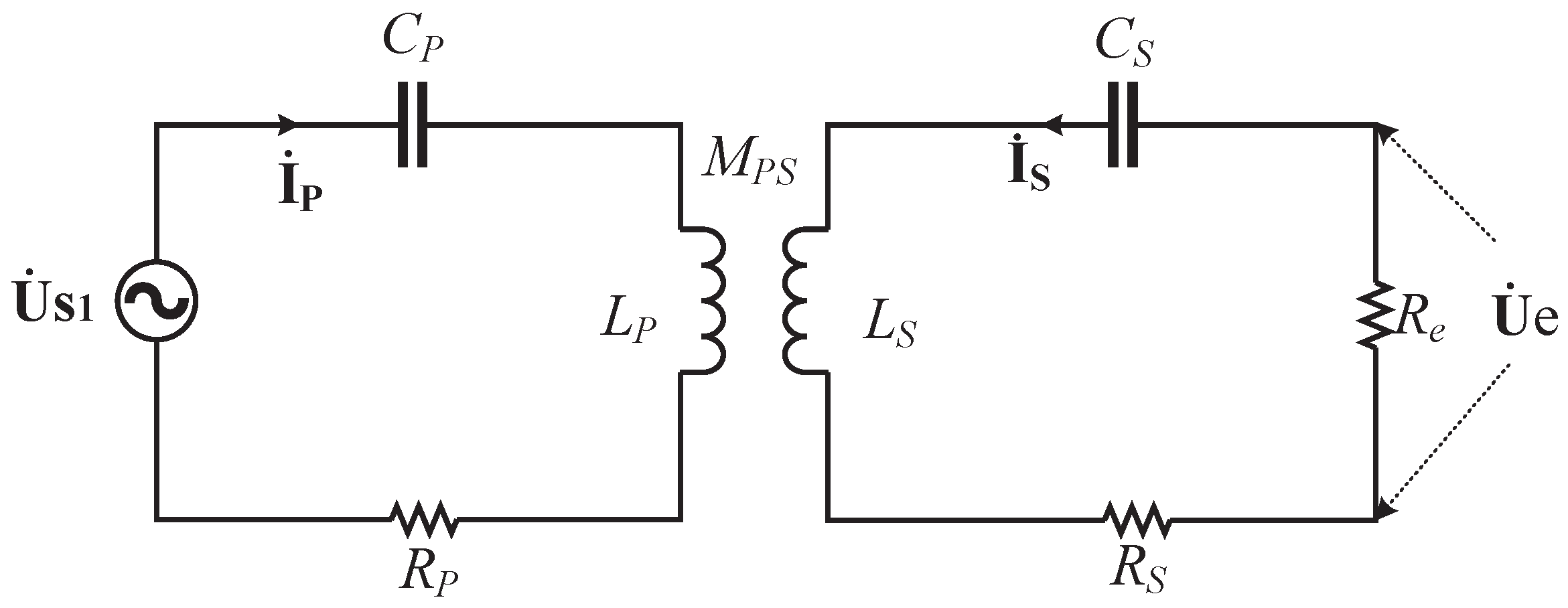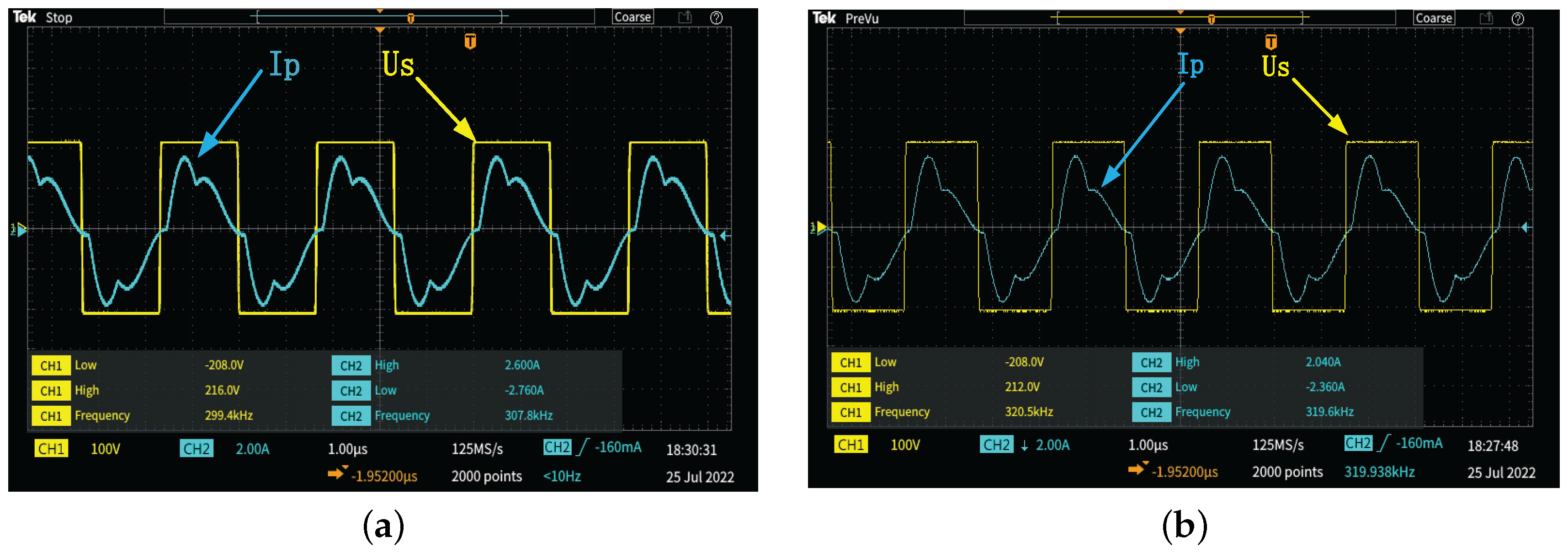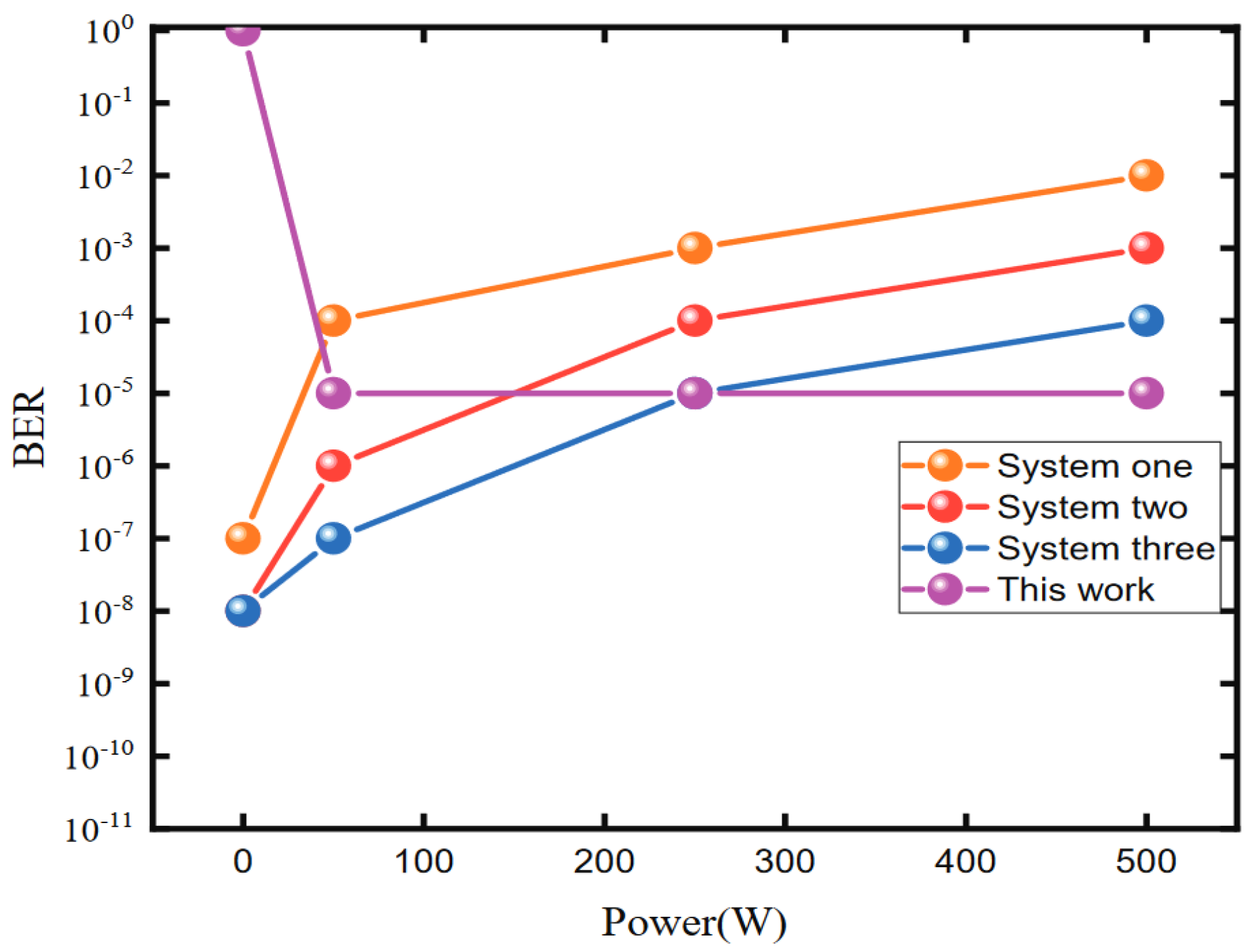1. Introduction
WPT technology has been widely employed due to its advantages of contactless connection between power source and load. In the fields of consumer electronics, electric vehicles, underwater devices and biomedical implants, wireless charging is becoming an increasingly popular way of power supply [
1,
2,
3,
4,
5,
6]. In some application scenarios, additional communication is usually required for power transmissions. For example, the automatic-guided vehicle (AGV) needs to obtain navigation information while receiving power. The implanted medical devices not only need to receive energy but also need to interact with the external monitoring devices.
Generally, the conventional transmission method of power and data can be divided into two categories; one is setting an independent data transmission channel and the other is that the power and data transmission share one common channel. For the first approach, wireless data transmission technologies such as Bluetooth, Wi-Fi, and radio-frequency (RF) communication can be employed in WPT systems for achieving information exchange [
7,
8]. These methods can easily achieve high-speed communication, but extra antennas are needed. It is also a good choice to use independent coils for near-field couplings. Reasonable coil design can reduce the mutual interference between electric energy and data transmission channels to a certain extent [
9]. Such methods require additional data transmission channels and generally have a relatively large scale. The transmission method of wireless power and data via one common channel does not need an additional data communication antenna. The inherent coupling coils for power transmissions are exploited as an antenna for data transmission, where the data are injected on the power carrier by inductance or capacitance [
10,
11,
12]. Usually, the working frequency of the power transmission channel and the data transmission channel is different to reduce the mutual interference. Nevertheless, the power transmission channel is a frequency selective channel, and the transferred data will be weakened by the resonance network of the power transmission channel. In order to reduce the interferences from the power channel to the data channel, high-order filters are usually added to the data channel to reduce the interferences. However, with the increase of the power transmission, the data transmission channel is inevitably affected.
The communication technologies used in these existing systems include amplitude-shift keying (ASK) modulation, the phase-shift keying (PSK) modulation, and the frequency-shift keying (FSK) modulation. Although the method based on ASK is simple in modulation and demodulation, its anti-noise performance is relatively poor; especially when the power transmission is relatively large, this modulation method can hardly work stably [
13]. The method based on PSK has a relatively better anti-noise performance, but the demodulation method is usually more complex [
14]. Therefore, the binary frequency shift keying (2FSK) modulation and demodulation technology is widely applied because it has better anti-noise performance than ASK technology and a simpler demodulation method than PSK [
15]. However, the technology based on 2FSK requires two different carriers to transmit information. In order to reduce the impact of power transmission, the carrier frequency of data transmission is usually high. As mentioned above, the signal with high carrier frequency will be seriously attenuated by the power transmission channel. It is a good choice to use two frequencies close to the resonance point of the power transmission channel for data transmission, which can avoid the attenuation of the data carrier by power transmission channel. However, when the interval between the two frequencies is relatively small, it is a very challenging thing to demodulate the data through the conventional method that uses a band-pass filter and envelope detector. In order to improve the signal-to-noise ratio, automatic gain control (AGC) technology is often used to automatically adjust the amplitude of the signal [
16,
17,
18].
In this paper, a wireless power and data transmission system using 2FSK modulation is proposed. Data modulation is achieved by switching the frequency of the inverter. The frequency modulation signal with data information can be obtained by collecting the signal in front of the rectifier circuit. Different from the conventional demodulation methods, the frequency-tracking characteristics of the PLL are used to identify the carrier frequency. The method proposed in this paper does not need an additional modulation circuit, and the carrier frequency used for data communication is similar to the resonant frequency of the power transmission circuit, so the data transmission is not affected by the power transmission; at the same time, the communication performance is not affected by the increase of power transmission.
The organization of this paper is as follows. The power transfer analysis is given in
Section 2. In
Section 3, the method of data modulation and demodulation is introduced. The interference between power transmission and the data transmission channel is discussed in
Section 4. In
Section 5, a prototype is built to verify the performance of the proposed method. Finally, the conclusions are summarized in
Section 6.
2. Power Transfer Analysis
There are various compensation topologies for efficient and stable power transmission. This paper emphasizes how to transmit data while transmitting electric energy. Hence, a series-series (S-S) compensated network is taken as an example because of its simple tuning. The schematic circuit of the proposed system is shown in
Figure 1. The system consists of an inverter, two coupling coils, a rectifier, compensation networks, and demodulation circuits. The transmission of power and data is achieved through the same pair of magnetic coupling coils. The power transmission channel is exactly the same as the S-S compensated WPT system. The data transmission is achieved by the modulation and demodulation technology based on FSK; that is, the digital signal 0 or 1 is transmitted by changing the excitation frequency of the inverter. In order to reduce the influence of frequency change on power transmission efficiency, the default frequency of FSK modulation is the resonant frequency of the circuit, and the other frequency is slightly higher than the resonant frequency, which can ensure that the circuit always works in the soft switching state. Thanks to the function of the filter capacitor
, when the working frequency changes, a square wave can be obtained before the rectifier circuit. Data demodulation is achieved by sampling the voltage waveform in front of the rectifier circuit. In order to reduce the influence of the demodulation circuit as a load on the power transmission channel, the demodulation circuit is designed with high input impedance, which can be equivalent to an open circuit state for the power transmission channel.
As shown in
Figure 2, the equivalent circuit of the power transmission is completely consistent with the WPT circuit of S-S compensation, where
are the parasitic resistances of the primary and secondary coils;
and
are the self-inductances, respectively;
are the resonant capacitors connected in series with the two coils.
is the mutual inductance between the two coils;
is the alternating current (AC) equivalent load at the rectifier circuit;
are adopted to represent the phasor form of the corresponding variables. Based on the fundamental harmonic analysis (FHA), the following equation can be obtained
where
represents the fundamental wave of
;
;
;
. Based on (
1), the transmission ratio of voltage and current can be derived as follows
Then, the efficiency of power transmission can be expressed as
When the circuit is fully resonant, that is, when the excitation frequency meets
,
can be expressed as
Obviously, the frequency is an important factor affecting the efficiency of power transmission, so the parameter design for the data transmission channel needs to focus on the selection of the working frequency.
Figure 2.
Equivalent circuit of the SS-compensated WPT system.
Figure 2.
Equivalent circuit of the SS-compensated WPT system.
4. Crosstalk Analysis and Parameter Design
In the proposed system, data and power are transmitted via one common channel; therefore, the following problems must be considered: firstly, the interferences from power transmission to data transmission and, secondly, the interferences from data transmission to power transmission. The method proposed in this paper modulates the data by directly changing the frequency of the inverter, and it demodulates the data by tracking the frequency of the square wave signal in front of the rectifier circuit. Therefore, it can be considered that the output power has no effect on data transmission. However, changing the frequency of the inverter will change the working state of the power transmission circuit, so it will affect the efficiency of power transmission.
Figure 5 shows the change of power transmission efficiency with the working frequency under variable coupling coefficient k.
It can be seen from
Figure 5 that when the coupling between the coils is relatively strong, the decline of power transmission efficiency is relatively flat when the working frequency deviates from the resonant frequency. The weaker the coupling between the coils, the more obvious the influence of frequency shift on power transmission efficiency. When the load resistance is 1 Ω, the power transmission efficiency is most sensitive to the frequency shift. A small load resistance will lead to a large reflection impedance. The primary side is close to open circuit and the secondary side is close to a short circuit. Similarly, when the load resistance is too large, the reflection impedance is very small, which will lead to the primary side close to short circuit and the secondary side close to open circuit. These two working states should be avoided when using S-S compensation topology.
Although increasing the carrier frequency can indeed improve the communication rate, the increase of the inverter switching frequency will not only increase the switching loss of the MOSFETs but also increase the parasitic resistance of the circuit due to the increase of the frequency. In view of the above reasons, we design the resonant frequency of the circuit as 300 kHz and choose another carrier frequency as 320 kHz. The ratio of the two frequencies is about 1.07. During communication, 15 cycles sent at 300 kHz represent the symbol 1, and 16 cycles sent at 320 kHz represent the symbol 0. This can ensure that each frequency can send a complete cycle in the communication process. In addition, sending multiple cycles to represent a symbol also leaves enough time for the acquisition and tracking of the demodulation circuit, which can reduce the bit error.
5. Experimental Verification and Discussion
In order to validate the proposed method, a prototype is constructed as shown in
Figure 6. Four SiC MOSFETs WM2M120080 and SiC didoes SA1D120020SC are used to build a full-bridge inverter and a full-wave rectifier, respectively. Litz wire with 0.1 mm × 100 strands is selected for coil processing in order to reduce the AC resistance. The mutual inductance between the two coils is obtained according to the in-phase and the opposing-phase connections of the coils [
20], which is measured by an LCR-8205 impedance analyzer. The key parameters of the system are listed in
Table 1.
When modulating the FSK signal, the working frequency of the inverter needs to work in the state of resonant frequency and nonresonant frequency.
Figure 7 shows the waveform when the inverter operates at 300 kHz and 320 kHz. It can be observed that when the frequency of the inverter deviates from the resonance point, the phase difference between the current and the voltage does not increase significantly, which indicates that the resonant state of the circuit is not seriously affected when the frequency of the inverter deviates from the resonant point of the circuit. However, when the inverter works in the nonresonant state, the area surrounded by the current waveform and the coordinate axis is significantly reduced, which indicates that the output power is reduced.
The carrier of data modulation is 300 kHz and 320 kHz, and the bandwidth of the loop filter is set to 10 kHz, which can ensure that when the inverter works at these two frequencies, one frequency point can be locked normally, and the other frequency point cannot be locked so as to achieve data demodulation. In order to verify the effectiveness of the data demodulation circuit, the frequency of the inverter is switched every 100 uS; that is, 0 and 1 are sent periodically at a baud rate of 10 kbps. The input and output voltage waveform of the demodulation circuit are shown in
Figure 8. The demodulation circuit can successfully recover the information modulated by the inverter. The lock and loss of PLL will take some time, so when modulating the signal, it needs to use multiple carrier cycles to represent a symbol bit. Compared with ASK, PSK and other demodulation methods, FSK needs to occupy a larger bandwidth.
In the system where wireless power and data are transmitted together, the influence of electric power on data transmission is mainly reflected in the influence on communication error rate. In order to verify the influence of the output power on data transmission, the number 60 is sent continuously at the sending end according to UART protocol. The data are recorded in real time at the receiving end. By increasing the output power and analyzing the bit error rate of the data, the influence curve of output power on bit error rate can be obtained. Each group of experiments is tested for 10 min. At the same time, we simulate and compare the bit error rate of [
13,
15,
21] under different output power for comparing the performance of the method proposed in this paper. The change curve of bit error rate with output power is shown in
Figure 9. It can be seen that when the output power is small, the bit error rate of the proposed system is relatively large, and when the output power is about more than 10 W, the bit error rate level tends to stabilize. This is because at low output power, the signal received by the demodulation circuit end is relatively small, resulting in a low signal-to-noise ratio. When the output power increases, the signal at the data demodulation circuit end gradually increases and finally saturates. Therefore, the bit error rate tends to stabilize when the power increases to a certain extent. Compared with the proposed method, the bit error rate of the other three systems will increase with the increase of the output power. However, when there is no power transmission, the three systems can communicate normally, but the method proposed in this paper cannot work normally.
The other performance of the system presented in [
13,
15,
21] is compared and tabulated in
Table 2. The maximum communication rate is evaluated when the system can communicate normally at the output power. The communication rate of the system in [
15] can reach 119 kbps. The output power of the systems in [
15] is relatively small. The data carrier frequency of most systems is at the MHz level. Compared with the reported systems, the system proposed in this paper does not need an additional modulation circuit; hence, the circuit structure is simpler.















